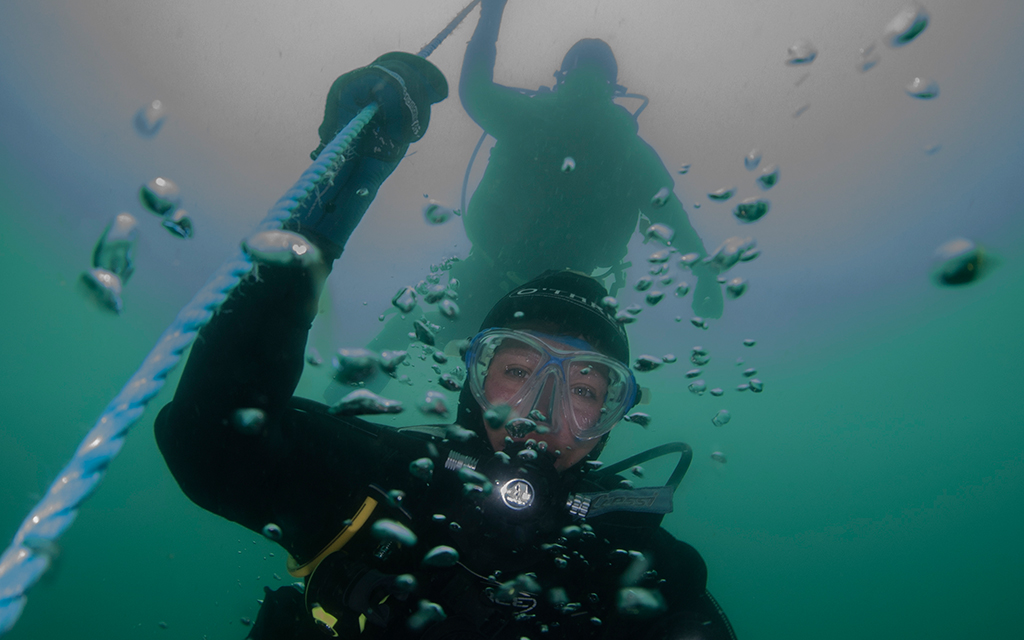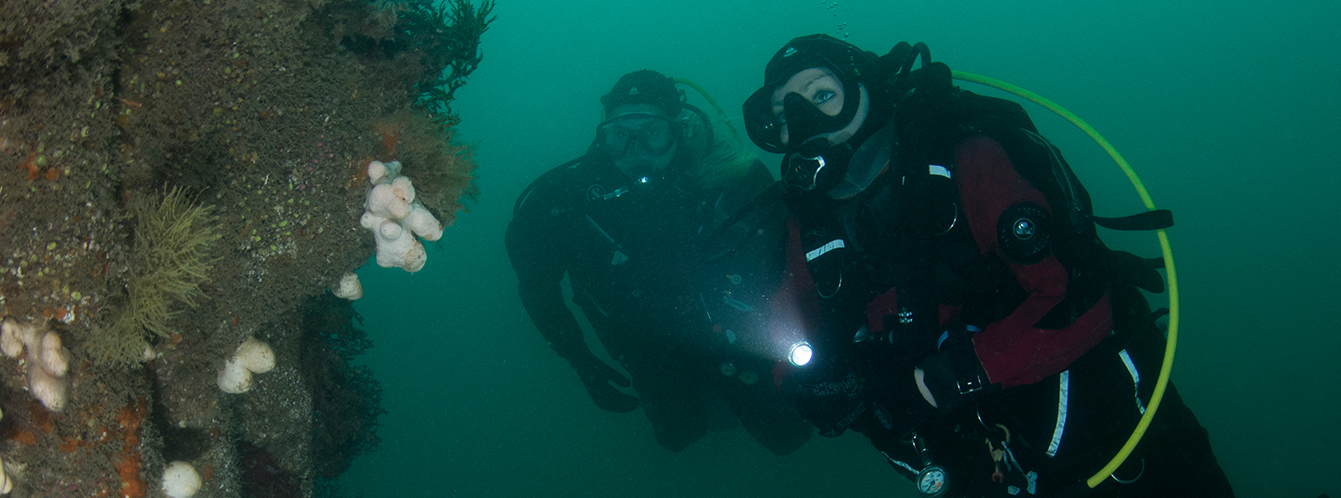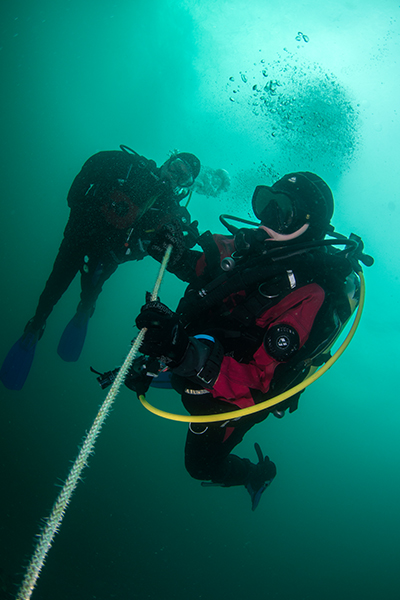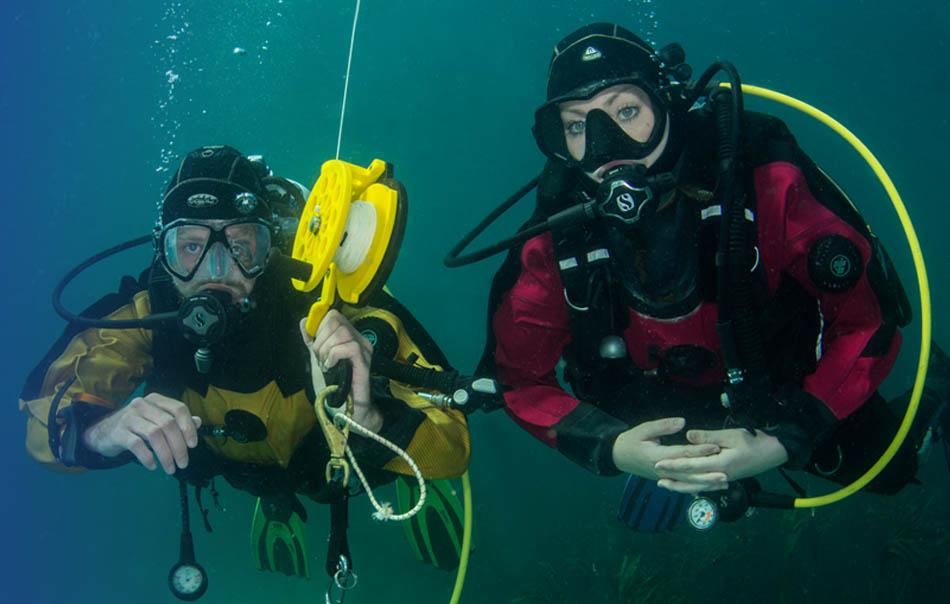
National Instructor Louise Whitehouse takes a look at the culture surrounding deeper diving.
I learned to dive with a university branch in my mid-20s and to be honest once you’d completed a qualification it was all about the depth progression. Everyone wanted to get the next box ticked off in their qualification book so that they could delve another five metres into the depths. Fifty metres was the target that everyone had in mind, for no reason other than not wanting to be left behind.
As I developed as a diver (and got a little older and more sensible) the appeal of bounce diving to 50m on air for the sake of it lost its appeal, as did carrying out unnecessary decompression. My choice of dive tends to be based around what I want to see, and now I prefer 30m or so, with minimal decompression and maximum bottom time breathing an appropriate nitrox mix.
Diving deeper inevitably means greater risk, a need for better skills and more comprehensive planning. While deeper diving can provide opportunities to see all sorts of exciting things, you need to do it for the right reasons and with the appropriate preparation.
Physics and physiology at depth
Just as air exerts pressure on us when we’re on land, once underwater we’re affected by the pressure of the air and the water surrounding us. At sea level, the air in the atmosphere exerts a pressure of one kilogram on every square centimetre of surface, known as one bar.
Water in a column with a cross-section of one square centimetre exerts a downward pressure of one bar for every 10m of depth, which adds to the air pressure to give us the total pressure we will experience at any depth underwater. For example, at 10m we will experience a pressure of one bar from atmospheric pressure and one bar from the water, which gives a total or ‘absolute’ pressure of two bar.
Understanding the effect this pressure has on our bodies underwater is important when it comes to appreciating the potential impacts of deeper diving and the importance of carrying it out safely. On the surface, the tissues of your body are in equilibrium with nitrogen in the atmosphere, the body cannot absorb any more nitrogen. But on a dive the increase in the ambient pressure surrounding us results in more nitrogen dissolving in the body, this is known as nitrogen on-gassing.
Going deeper increases the nitrogen on-gassing, which in turn will increase the amount of gas that needs to leave the tissues to re-establish equilibrium at the surface. This increases the need for careful dive planning. It also requires the diver to have the skills needed to ensure a well-controlled ascent to allow the reverse process of off-gassing to occur safely. This need to carry out a steady ascent and accurate decompression stops means that deeper diving requires excellent buoyancy skills. Divers also need enough experience to understand the risks and to be able to plan the best way to carry out the dive to get the most out of it. This applies just as much to a first dive to 25m as a first dive to 50m.
Irrespective of why you want to do it, diving deeper does need a suitable dive plan, equipment and surface support. If depth progression is going to be enjoyable it needs to be commensurate with the diver’s skills and experience, otherwise what should have been an enjoyable dive can be at best underwhelming and at worst a frightening or dangerous experience.

Depths for BSAC diver grades
Discovery Diver: maximum depth 12m
Ocean Diver: maximum depth 20m, once achieved under supervision
Sports Diver: depth progression in 5m increments from 20m post-qualification to a maximum of 40m
Dive Leader: depth progression in 5m increments from 35m post-qualification to a maximum of 50m
Narcosis
In my experience, nitrogen narcosis - also called getting narked - is something that can take a straightforward and enjoyable dive and turn it into a miserable, intimidating or panicky one. Divers generally notice the effects at around 30m, but some are more aware of narcosis than others. The effects can vary not only from diver to diver but also from dive to dive. The deeper you go the greater the effect.
What causes nitrogen narcosis isn’t well understood, but it is generally believed that nitrogen, which is very soluble in fat, enters the highly fatty nerve cells and then impairs the transmission of nerve impulses which control conscious and subconscious body actions and responses. With the raised partial pressure of nitrogen proportionate to the increase in depth, the impairment of transmissions becomes greater with increasing depth.
The effects are similar to those of anaesthetics or alcohol, which means that memory and concentration can be affected, as well as reasoning and judgement. On a light, bright dive in comfortable conditions this can be relatively pleasant and relaxing. On a dive where you’re already feeling challenged, it can be the last straw.
We were diving out of North Berwick from a RIB and had spent a long time trying to shot a submarine in around 45m. I get seasick at the best of times and these were not the best of times, shuffling backwards and forwards across a dive site is the perfect way to make me feel absolutely dreadful. Once the shot was on the wreck I seriously considered not diving, however, this would have meant another hour sitting on the RIB waiting for divers to return and at this point, the only thing I wanted to do was get off the boat.
So I dived, I was cold and not feeling great. The dive was also cold and it was dark. We got down to the bottom to find the shot wasn’t on the wreck and the first pair down had reeled off to find it. We followed the line and eventually arrived at the sub. Narcosis affected me very negatively. I did not enjoy the dive and spent the decompression stops shivering. We were all glad to get back to dry land that day.
A friend who did the same dive remembers nothing of it due to narcosis, he’s often affected that way and we’ve often wondered why he bothers when he doesn’t even have memories of the wreck to take back with him. Divers are a funny bunch.

Should we dive deeper?
Looking back on everything I’ve said it’s easy to wonder if we should all give up diving deep and stick to pottering around at 25m (which is still deep if you’ve only been to 15m before). However that would mean that we’d miss out on so much: the opportunity to see the remains of the incredible German High Seas Fleet battleships in Scapa Flow, Orkney; or that sense of scale when you are hanging midway down a near-vertical wall at 40m with the possibility of dropping down even further.
As with everything in diving it’s about appropriate training, experience and equipment and following a well-thought-out plan. Every dive is potentially dangerous, but it is by making use of our training that we are able to enjoy being in an environment that we are fundamentally not designed for. So we strap a load of crazy kit to ourselves and dive in. Deeper diving can be amazing, but first think about why you want to do it and then learn to do it properly.
Why dive deeper?
Having given this some serious thought, I think that the reasons people want to dive deeper fall into three very broad categories.
1. To see something special
Whether it’s a wreck, a reef or a certain creature, or wanting to visit a specific must-see dive site that’s just out of reach, is a major driver for pushing depth experience. Whether you want to get to 45m in Scapa Flow, Orkney, to explore the German battleship Markgraf or drop a little bit deeper on the Hispania in the Sound of Mull on the west coast of Scotland, there are many sites that push divers to complete qualifications so they can dive deeper.
While this is a good reason to extend experience, it can also be a motivation to go too deep too soon. While the thought of missing out is not appealing, there will be other opportunities to do the dives that you’re missing out on, so there’s no need for Ocean Diver trainees to be hitting 25m just because everyone else is.
2. Because you can…
For some, each dive is about the next challenge and it’s always possible to go deeper, it’s just about the continual desire to keep pushing. This can be one of the trickiest motivations to manage because there’s no reason to stop. Each dive is a little bit deeper than the last. It’s also very easy to be swept along in the enthusiasm of others. My initial depth progression was driven by wanting to be as good as everyone else, which meant being able to dive as deep as everyone else, whether it was worth seeing or not.
3. The technical challenge
A lot of divers are drawn to learn something new and the desire to push ourselves can be a brilliant motivator to take on Dive Leader training or enter the National Instructor development fray. Diving deep means overcoming a range of physical challenges and using appropriate kit and gases to do that. The interest in trying new things such as twinsets, mixed gas and rebreathers, and then developing the skillset to get the most out of them, can be the driving force behind interest in going deeper. In addition, looking at the use of support equipment, shot lines, trapezes and even support divers for such dives will arm us with the toolkit of skills and support that’s needed to go deeper than we’ve done before. Improving your skills and learning new techniques or experimenting with different kit is a great way to broaden the type of dives you have access to, but if you’re intending to use new kit to support your access to deeper sites it’s essential to put in the underwater hours at shallower depths to make sure you can execute the dive safely
Progress your depth
BSAC has a range of courses to teach you the skills you need to safely dive deeper. These include appropriate gas planning (Dive Leader, Twinset Diver), how to manage narcosis (Nitrox workshop, Mixed Gas, CCR), as well as how to increase your bottom time safely and manage decompression schedules (Accelerated Decompression Procedures).
For more information on courses in your area, go to bsac.com/events.
This Learning Curve was originally published in SCUBA Magazine Issue 94, September 2019.

 Author: Louise Whitehouse | Posted 08 Dec 2019
Author: Louise Whitehouse | Posted 08 Dec 2019



